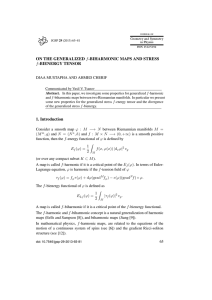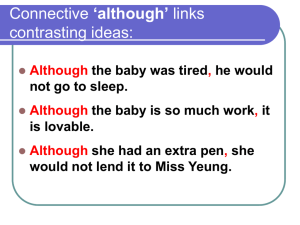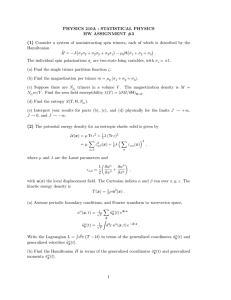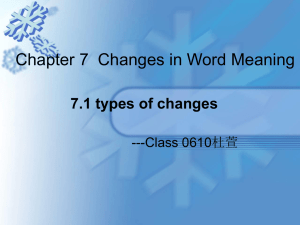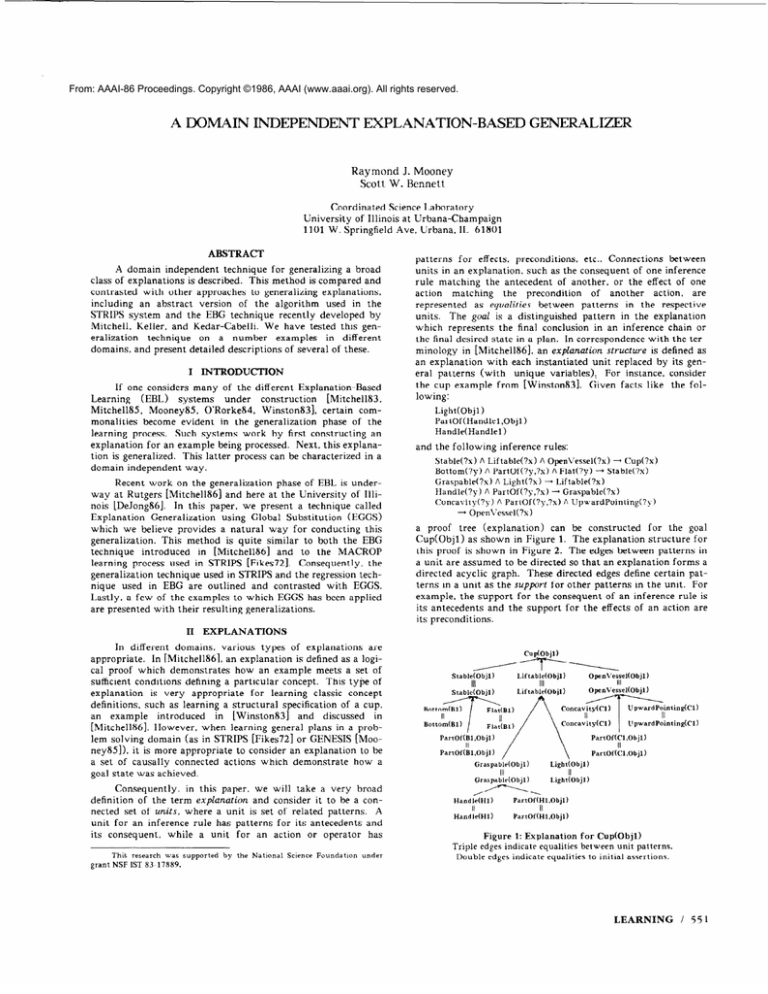
From: AAAI-86 Proceedings. Copyright ©1986, AAAI (www.aaai.org). All rights reserved.
A DOMAIN INDEPENDENT EXPLANATION-BASED
GENERALIZER
Raymond J. Mooney
Scott W. Bennett
Coordinated
Science Laboratory
University
of Illinois at Urbana-Champaign
1101 W. Springfield
Ave. Urbana, IL 61801
ABSTRACT
A domain independent
technique
for generalizing
a broad
class of explanations
is described.
This method is compared and
contrasted
with other approaches
to generalizing
explanations,
including
an abstract
version
of the algorithm
used in the
STRIPS system
and the EBG technique
recently
developed
by
Mitchell,
Keller, and Kedar-Cabelli.
We have tested this generalization
technique
on a number
examples
in different
domains. and present detailed descriptions
of several of these.
I
INTRODUCTION
If one considers
many of the different
Explanation-Based
Learning
(EBL)
systems
under
construction
[Mitchell83,
Mitchell85.
Mooney85.
O’Rorke84.
Winston831.
certain
commonalities
become evident
in the generalization
phase of the
learning
process.
Such systems
work by first constructing
an
explanation
for an example being processed.
Next, this explanation is generalized.
This latter process can be characterized
in a
domain independent
way.
Recent work on the generalization
phase of EBL is underway at Rutgers [Mitchell861
and here at the University
of Illinois [DeJong86].
In this paper, we present a technique
called
Explanation
Generalization
using Global Substitution
(EGGS)
which we believe provides
a natural
way for conducting
this
generalization.
This method
is quite similar
to both the EBG
technique
introduced
in [Mitchell&]
and to the MACROP
learning
process used in STRIPS [Fikes72].
Consequently,
the
generalization
technique
used in STRIPS and the regression technique used in EBG are outlined
and contrasted
with EGGS.
Lastly, a few of the examples
to which EGGS has been applied
are presented
with their resulting
generalizations.
II
Light(Obj1)
PartOf(Handlel,Objl)
Handle(Handlel>
and the following
inference
rules:
Stable(?x) A Liftable
A Open\‘essel(?x) + Cup(?x)
Bottom(?y) A PartOf(?y,?x)
A Flat(?y) + Stable(?x)
Graspable
A Light(?x) - Liftable
Handle(?y) A PartOf(?y,?x)
+ Graspable
Concavity(7y)
A PartOf(?y,?x)
A UpurardPointing(?y)
+ Open\‘essel(?x)
a proof
tree (explanation)
can be constructed
for the goal
Cup(Obj1)
as shown in Figure 1. The explanation
structure
for
this proof is shown in Figure 2. The edges between patterns
in
a unit are assumed to be directed so that an explanation
forms a
directed
acyclic graph.
These directed edges define certain patin the unit. For
terns in a unit as the support for other patterns
example,
the support
for the consequent
of an inference rule is
its antecedents
and the support
for the effects of an action are
its preconditions.
EXPLANATIONS
In different
domains.
various
types of explanations
are
appropriate.
In [Mitchell%],
an explanation
is defined as a logical proof which demonstrates
how an example meets a set of
sufficient conditions
defining a particular
concept.
This type of
explanation
is very appropriate
for learning
classic concept
definitions,
such as learning a structural
specification
of a cup,
in [Winston831
and
discussed
in
an example
introduced
[Mitchell86].
H owever. when learning
general plans in a problem solving domain (as in STRIPS [Fikes72] or GENESIS [Mooney85]).
it is more appropriate
to consider an explanation
to be
a set of causally
connected
actions which demonstrate
how a
goal state was achieved.
Consequently,
in this paper, we will take a very broad
definition
of the term explanation
and consider
it to be a connected set of units, where a unit is set of related patterns.
A
unit for an inference
rule has patterns
for its antecedents
and
its consequent,
while a unit for an action
or operator
has
ThiS research was supported
grant NSF IST 83 17889.
by the Natlonal
Science Foundation
under
Stable(Obj1)
III
OpenC’esselfObjl)
Liftable(Obj1)
III
Ill
PartOf(Bl,Objl)
”
PartOf(Bl.Objl)
/
Graspable(Obj1)
Light(Obj1)
Ill
II
Graspablr(Obj1)
Handie
HandIe
Light(Objl)
PartOf(Hl.Objl)
II
PartOf(Hl,Objl)
Figure 1: Explanation
for Cup(Obj1)
Triple edges indicate equalities between unit patterns.
Double edges indicate equalities to initial assertions.
LEARNING
/ 551
The task of explanation-based
generalization
is to take an
explanation
and its associated
explanation
structure
and genexplanation.
which is the most general vererate a generalized
sion which still maintains
the structural
validity
of the original
explanation.
This means that substitutions
must be applied to
the patterns
in the explanation
structure
so that it is constrained
in such a way that equated
patterns
unify directly
without
requiring
any substitutions.
The generalized
explanation of the cup example is shown in figure 3. This generalized
explanation
can then be used to extract
the following
general
definition of a cup:
Bottom(?yl)
A PartOf(?yl
.?xl> A Flat(?yl>
A Handle(?y2)
A PartOf(?y2.?xl)
A Light(?xl)
A Concavity(?y3)
A PartOf (?y3.?x 1) A UpwardPointing(?y3)
+ Cup(?x 1)
In problem
solving
domains,
represents
a general plan schema
Stable(?xl)
III
Stable(?x2)
Liftablee(?xl)
III
Liftable(?x3)
Graspable(?x3)
Ill
Graspable(?x4)
Handle(?yZ)
Figure
the generalized
explanation
or MACROP
for achieving
a
OpenVessel(?xl)
III
Lighk?x3)
PartOfVy2,?x4)
2: Explanation
Structure
for Cup Example
Triple edges indicate equalities between unit patterns.
Stable(?xl)
Lif table(?xl
Ill
)
ill
Stable(?xl)
OpenVessel(?xl)
Ill
Liftable(?xl)
parrOf(:yl,?xl)
/
Graspable(?xl)
III
Graspable(?xl)
Handlk?y2)
\
PartOfhWxl)
Light(?xl)
PartOf(?yZ,?xl)
Figure 3: Generalized Explanation
for Cup Example
Triple edges indicate equalities between unit patterns.
particular
III
class of goals.
EXPLANATION
GENERALIZING
ALGORITHMS
Several algorithms
have been developed
for generalizing
various
types of explanations.
The STRIPS system
[Fikes72]
incorporated
a method for generalizing
blocks-world
plans into
MACROPS.
The EBG method [Mitchell%]
uses a modified version of goal-regression
[Waldinger77]
to generalize
proofs of
concept
membership.
Concurrently
with
Mitchell
et. al’s
development
of EBG. we developed
a method
[DeJong86]
(which we now call EGGS) which generalizes
the broad class of
explanations
defined in the previous section. However.
the general
techniques
used
by the other
two methods
can be
abstracted
to apply to the class of explanations
defined above.
Consequently,
this section is devoted to presenting
and comparing algorithmic
descriptions
of all three methods
as applied to
this class of explanations.
All of the algorithms
rely on
552
/ SCIENCE
unification
pattern
matching
and
notation
described in [NilssonSO].
A.
STRIPS
MACROP
we will
use the
unification
Learning
The first work on generalizing
explanations
was the learning of robot plans in STRIPS [Fikes72].
STRIPS worked
in a
“blocks
world”
domain
and after
its problem
solving
component generated
a plan for achieving a particular
state, it generalized the plan into a problem
solving schema (a MACROP)
which could be used to efficiently solve similar problems
in the
future.
Work on the STRIPS system was the first to point out
that generalizing
a causally
connected
set of actions or inferences could not be done by simply replacing each constant
by a
variable.
This method
happens
to work on the cup example
given
above.
The proper
generalized
explanation
can be
obtained
by replacing
Objl by ?xl, Bl by ?yl. Hl by ?y2, and
Cl by ?y3. However,
in general, such a simplistic
approach
can
result
in a structure
which
is either more general
or more
specific than what is actually
supported
by the system’s domain
knowledge.
The following
examples are given in [Fikes72] to illustrate
that simply
replacing
constants
with variables
can result in
improper
generalizations.
The following
operators
are used in
these examples: GoThru(?d,
?rl, ?r2) {Go through
door ?d from
room ?rl to room ?r2) PushThru(?b.
?d, ?rl. ?r2) {Push box ?b
through
door ?d from room ?rl to room ?r2) SpecialPush
{Specific operator
for pushing
box ?b from Room2 to Rooml).
Given
plan:
the
GoThru(Door1,
Rooml,
Room2Z),
SpecialPush(Boxl>.
simply
replacing
constants
by variables
results in the plan: GoThru(?d,
?rl, ?r2). SpecialPush(
This
plan is too general since SpecialPush
is only applicable
when
starting
in Room2. so having a variable ?r2 as the destination
of
the GoThru is too general and ?r2 should be replaced by Room2.
Given
the
plan:
Rooml.
Room2 >,
GoThru(Door1,
PushThru(Box1.
Doorl,
Room2.
Room1 > simply
replacing
constants
by variables
results in the plan: GoThru(?d,
?rl, ?r2).
PushThru(?b,
?d. ?r2. ?rl).
This plan is too specific since the
operators
themselves
do not demand that the room in which the
robot begins (?rl)
be the same room into which the box is
pushed.
The correct
generalization
is: GoThru(?d.
?rl. ?r2).
PushThru(?b,
?d. ?r2. ?r3).
The exact process STRIPS uses to avoid these problems and
correctly
generalize
an example is dependent
on its particular
representations
and inferencing
techniques:
however,
the basic
technique
is easily captured
using the representations
discussed
in section II. How STRIPS problems
are represented
with interconnecting
units will be clarified with an example later in the
paper.
However,
assuming
they are represented
in this fashion.
a description
of the explanation
generalizing
algorithm
is shown
in Table 1. It should be noted that the generalization
process in
STRIPS was constructed
specifically
for generalizing
robot plans
represented
in triangle
tables and using resolution
to prove
preconditions.
There was no attempt
to present a general learning method based on generalizing
explanations
in any domain.
genHowever,
the algorithm
in Table 1 is a straight-forward
eralization
of the basic process used in STRIPS. The basic technique is to unify each pair of matching
patterns
in the explanation structure
and apply each resulting
substitution
to all of the
for each equality between pi and p, in the explanation
structure
let 8 be the MGU of p, and p
for each pattern pk in the exblanation
replace
p,
structure
do
with p,6
Table 1: STRIPS Explanation
Generalization
Algorithm
do
patterns
in the explanation
structure.
After
all of the
unifications
and substitutions
have been made, the result is the
generalized
explanation
since each pattern
has been replaced by
the most general
pattern
which
allows
all of the equality
matches in the explanation
to be satisfied.
B.
EBG
Mitchell,
Keller, and Kedar-Cabelli
[Mitchell861
outline a
technique
for generalizing
a logical
proof
that a particular
example satisfies the definition of a concept. An example of such
a proof is the one in Figure 1 explaining
how a particular
object
satisfies
the functional
requirements
of a cup.
Unlike
the
STRIPS MACROP learning
method. EBG is meant to be a general method
for learning
by generalizing
explanations
of why
an example
is a member
of a concept.
The EBG algorithm
is
based
on
regression
[Waldinger77]
and
involves
backpropagating
constraints
from
the goal pattern
through
the
explanation
back to the leaves of the explanation
structure.
This process obtains the appropriate
generalized
antecedents
of
the proof: however,
as pointed
out in [DeJong86],
it fails to
obtain the appropriately
generalized
goal pattern and remaining
explanation.
As indicated
in [DeJong86]
and as originally
specified in [Mahadevan85].
the remaining
generalized
explanation
must
be obtained
by starting
with
the generalized
antecedents
obtained
from regression
and rederiving
the proof.
This propagates
constraints
forward
from
the generalized
antecedents
to the final generalized
goal concept.
Hence, the
correct
EBG algorithm
involves
both a back-propagate
and a
forward-propagate
step as is shown in the abstract
algorithm
in
Table 2. Once again, the result of the EBG algorithm
is the generalized explanation
since each pattern
has been replaced by the
most general pattern
which allows all of the equality
matches
in the explanation
to be satisfied.
let g be the goal pattern
BackPropagate(g 1
ForwardPropagate
in the explanation
structure
Finally,
there is the EGGS algorithm
which we developed
to generalize explanations
of the very abstract form defined and
used in this paper.
The algorithm
is quite similar
to the
abstract
STRIPS algorithm
and is shown
in Table 3. The
difference
between EGGS and the abstract
STRIPS algorithm
is
that instead of applying
the substitutions
throughout
the explanation at each step, all the substitutions
are composed into one
substitution
7. After all the unifications
have been done, one
sweep through
the explanation
applying
the accumulated
substitution
y results
in the generalized
explanation.
Table 4
demonstrates
this technique
as applied
to the cup example
above. It shows how y changes as it is composed with the substitutions
resulting
from each equality.
Applying
the final
let y be the null substitution {}
for each equality between p, and pj in the explanation
let 8 be the MGU of pI and p,
p,
p do
pi
e do
procedure ForuardPropagate(p)
for each pattern pi supporting p do
if p, is equated to some pattern
then
let e be the pattern equated to p,
ForwardPropagate
let 8 be the MGU of p, and e
replace p, with p,0
replace p with p0
Generalization
Algorithm
structure
do
J
let y be ye
for each pattern p, in the explanation
replace pr. with pky
Table 3: EGGS Explanation
structure
Generalization
do
Algorithm
Table 4: EGGS Applied To the Cup Example
substitution
7 to the explanation
structure
the generalized
explanation
in Figure 3.
D. Comparison
procedure BackPropagate
for each pattern pi suPporting p do
if p, is equated to some pattern
then
let e be the pattern equated to
let 0 be the MGU of e and p,
replace p with p0
for each pattern p, supporting
replace p, with p,B
for each pattern pi supporting p do
if p, is equated to some pattern
then
let e be the pattern equated to
let 8 be the MGU of e and p,
replace e with e0
for each pattern p, supporting
replace pi with p,0
BackPropagate
Table 2: EBG Explanation
C. EGGS
of Explanation
in Figure
Generalizing
2 results
in
Algorithms
It is reasonably
clear that all of the above algorithms
compute the same desired generalized
explanation.
They all perform a set of unifications
and substitutions
to constrain
the
explanation
structure
into one in which which equated patterns
unify
directly
without
requiring
any
substitutions.
The
difference
between them lies in the number of unifications
and
substitutions
required
and the order in which they are performed.
Assuming
there are e equalities
and p patterns
in an explanation (p > e), the STRIPS method requires e unifications
each
resulting
in p applications
of a substitution
(i.e. ep substitutions).
The EBG method does a unification
for each equality
in
both the back-propagating
and forward-propagating
steps for a
total of 2e unifications.
The number
of substitution
applications required
by EBG depends on the number
of antecedents
for each rule, but in the best case (in which each rule has only
one antecedent)
it requires one substitution
for each pattern
in
both the back-propagating
and forward-propagating
steps for a
total of 2p substitutions.
Finally,
EGGS requires e unifications
to build the global substitution
(y) and p substitutions
to apply
y to the explanation
structure.
Each composition
of a substitution with 7 also requires a substitution,
so there are really e+p
overall substitutions.
Therefore,
EGGS does less unifications
and substitutions
than either the abstract
STRIPS method or EBG. However,
this
may be misleading
since the complexity
of each unification
or
substitution
depends
on the nature
of the patterns
involved.
Consequently,
these figures are not absolute complexity
results,
but only rough indications
of overall complexity.
LEARNING
/ 553
As described
in [O’Rorke85].
generalizing
explanations
can
be viewed as a process of posting and propagating
constraints.
Neither
the abstract
STRIPS algorithm
nor EGGS impose any
order on the posting of constraints
(equalities
between patterns)
and both simultaneously
propagate
constraints
in all directions.
EBG. on the other hand, imposes an unnecessary
ordering on the
posting
and propagation
of constraints.
First, constraints
are
propagated
back through
the explanation,
and then a second
pass is required
to propagate
constraints
forward
to obtain the
appropriate
generalized
goal concept.
We believe this adds undo
complexity
to the generalizing
algorithm
as is obvious
from
comparing
the algorithmic
descriptions
in Tables 1-3.
IV
Application
of EGGS to Several
Domains
The EGGS technique,
which has been fully implemented,
has generalized
explanations
in several
domains.
This set of
examples
currently
includes
narrative
understanding
[Mooney85], generating
physical
descriptions
of objects from functional
information
[Winston83].
designing
logic
circuits
[Mahadevan85,
Mitchell851,
solving
integration
problems
[Mitchell831
[Mitchell86].
proving
theorems
in mathematical
logic
[O’Rorke84].
the
Safe-To-Stack
problem
from
[Mitchell86],
th e suicide example from [DeJong86].
and STRIPS
robot planning
[Fikes72].
The Cup example
was discussed
in
detail in section 2. In this section, we will describe the application of EGGS to the logic circuit design, STRIPS robot planning,
and narrative
understanding
examples.
All of the examples are
discussed
in a longer version of this paper [Mooney86].
A. LEAP example
Esuiv(-(-(?al))A-(7(?bl)).?alA?bl)
Equiv(T(-(?bl)),?bl)
Equiv(?al,?al)
Figure
B. STRIPS
Equiv(?bl,?bl)
5: LEAP Example
circuit
examples
it
observes.
Given
the
task
Example
Action
GoThru(?a,?d,?rl
,?r2)
PushThru(7a,?o,?d,?rl,‘?r2)
Preconditions
Effects
InRoom(?a,?rl)
Connects(?d.?rl.%2
InRoom(?a,?rZl
Equiv(?x,?y)
---) Equiv(-t(y(?x)).?y>
Equiv((y?xAy?y),?a)
+ Equiv(-(?xV?y),?a)
Equiv(?x.?a)
A Equiv(?y.?b)
+ Equiv(?xA?y
Equiv(?x,?x)
1
InRoom(?a,?rl)
InRoom(?o,?r 1)
Connects(?d,?rl .?r2)
InRoom(?a,%2)
InRoom(?o,?r2)
An inference rule used in this example is: Connects(?d.
?rl. ?r2)
+ Connects(?d,
?r2, ?rl). The specific explanation
for this plan
is shown
in Figure 6. The resulting
generalization,
shown in
Figure 7, doesn’t constrain
the final destination
of the robot to
be the same as its room of origin.
The generalized
plan would
support having the robot move the box to a Room3 connected
to
Room2 rather than back to Rooml.
lnRoom(Robot,Rooml)
of
implementing
a circuit which computes
the logical function:
(a
V b) A (c V d), a circuit
designer creates a circuit consisting
of
three NOR gates computing
the function:
-(-(a V b) V -(c V d)).
The system attempts
to verify that the given circuit actually
computes
the desired function.
The explanation
proving that the
function
the circuit computes
is equivalent
to the desired function is shown in Figure 4. Since equated
patterns
are always
identical
in specific and generalized
explanations,
only one of
each pair will be shown
in this and future
figures.
In this
example, the domain knowledge
available
to the system is:
Explanation
The STRIPS
example
[Fikes72],
as discussed
earlier,
involves a robot, located in Rooml, moving to Room2 through
Doorl. picking up a box, and moving back to Room1 with the
box. An explanation
is constructed
for the example
using the
following
action definitions:
The LEAP system in [Mitchell851
is a learning apprentice
in VLSI design
which
observes
the behavior
of a circuit
designer.
It attempts
to learn in an explanation-based
fashion
from
-- Generalized
PushThru(Robot,Box,Drl,Rwm2,Rooml)
Connects(Doarl,Room2,Rooml)
InRoom(Robot,Room2)
InRoom(Robot,Rooml)
Figure
ConnectdDcarl,Rooml,Room2)
6: STRIPS Example
-- Specific Explanation
InRoom(?a2,?y27)
PushThru(?a2,?bl,7d2,?x27,?y27)
.?aA?b)
The generalized
form of this proof is shown in Figure 5. Had
constants
simply been replaced by variables,
the result would
have been overly specific.
As a result of the explanation-based
approach,
the resulting
generalization
is not sensitive to the fact
that the first stage of the circuit involved an aVb and a cVd. For
example,
the generalization
would support
using two NAND
gates and a NOR gate to AND four things together.
Connectsf?d2,?x27,?y27)
lnRoom(?a2,?x27)
t
Connects(?d2,?y27,?x27)
GoThru(?aZ,?dl,?xZl,?x27)
InRoom(?a2,?x21)
Connects(?dl.?x21,?x27)
Figure 7: STRIPS -- Generalized
C. GENESIS
Explanation
Example
The arson example from the GENESIS system[Mooney85]
is a more complicated
one in which domain specific generalization rules are used to augment
the normal
EGGS procedure.
The specific explanation
structure
shown
in Figure 8 is constructed
from the following
story which is presented
to the
narrative
understanding
system:
Equiv(-(&Vb)),aVb)
f
Equiv(aVb,aVb)
Figure 4: LEAP Example
554
/ SCIENCE
Equiv(-(&Vd)),cVd)
e
Equiv(cVd,cVd)
-- Specific Explanation
Stan owned a warehouse.
He insured it against fire for
$100,000.
Stan burned the warehouse. He called Prudential
and told them it was burnt. Prudential paid him $100,000.
The explanation
is that, since Stan s goal was to get money, he
insured an unburnt
warehouse
he owned with Prudential.
He
then proceeded
to burn down the flammable
warehouse
and to
Figure
8: GENESIS --
Specific
Explanation
Believe(!tl,Burnt(~4))
Ina(?tl,Charaeter)
Flsmmsble(li4)
Ias(!tl,Charaeter)
Possess(ltl,?il)
Figure
9: GENESIS - Generalized
telephone
Prudential
to tell them about it. Since Prudential
believed
the warehouse
was burnt,
the building
was insured
with them, and they had the requisite money to reimburse
Stan,
they paid him the indemnity.
The generalized
explanation
can be seen in Figure 9. In
addition
to the normal EGGS generalization
process, hierarchical
class inferences
(ISA inferences)
have been pruned to arrive at
an appropriate
generalization.
The rule is to prune any facts
supporting
only ISA inferences.
For instance.
in this example,
including
the fact that the object burned
was a warehouse
would make the resulting
generalization
overly specific and less
useful
in understanding
future
narratives.
However.
it was
important
to include warehouse
in the specific explanation
in
order to infer that it could be burned.
Since the fact that the
object was a warehouse
only supports
the fact that it is a building, this fact is removed from the generalized
explanation.
Likewise, the fact that the object is a building
is also pruned.
The
fact that the object is an inanimate
object cannot
be pruned
because it is a precondition
for burn, insure-object,
and indemnify. Consequently,
it becomes part of the generalized
structure.
V
Isa(?i4,Inanimate)
Explanation
[Fikes72]
R. E. Fikes, P. E. Hart and N. J. Nilsson, “Learning and
Artificial
Executing
Generalized
Robot
Plans,”
Intelligence
3, (19721, pp. 251-288.
[Mahadevan85]
“Verification-Based
Learning:
A
S.
Mahadevan,
for
Inferring
ProblemGeneralization
Strategy
Proceedings
of the
Ninth
Reduction
Methods,”
International
[Mitchell831
REFERENCES
[DeJong86]
T.
G. F. DeJong and R. J. Mooney, “Explanation-Based
Learning: An Alternative \‘iew,” Machine
Learning
I,
2 (April 1986), .
M.
Mitchell,
of
Proceedings
Conference
Germany,
[Mitchell851
Artificial
1985,
pp. 616-
Problem
Solving,w
International
Joint
Karlsruhe,
Intelligence,
West
i\ugust 1983, pp. 1139-1151.
of
Conference
International
Ninth
Joint
Los Angeles, CA,
Intelligence,
pp. 573-580.
T. M. Mitchell,
“Explanation-Based
.Ilachine
the
on Artificiul
-4ugust 1985,
[Mooney851
and
Eighth
on Artificial
Proceedings
[Mitchell861
“Learning
the
T. M. Mitchell, S. Mahadevan and L. I. Steinberg,
‘LEAP:
A Learning Apprentice for VLSI Design,”
Learning
R. Keller and S. Kedar-Cabelli,
Generalization: A Unifying L’iew,”
1, 1 (January
19861, .
R. J. Mooney and G. F. DeJong, “Learning Schemata
for Natural Language Processing,” Proceedings
of the
Ninth
with
on
623.
International
Intelligence,
Joint
Conference
on
Artificial
Los Angeles, CA, August 1985.
[Mooney861
R. Mooney and S. Bennett, “A Domain Independent
Explanation-based
Generalizer,” Working Paper 7 1, ii1
Research
Group, Coordinated
Science Laboratory,
University of Illinois, Urbana, Il., May 1986.
[Nilsson80]
N. J. Nilsson, Principles
Tioga Publishing Company,
[O’Rorke84]
P. V. O’Rorke, ‘Generalization for Explanation-based
Proceedings
of the National
Schema Acquisition,”
Conference
on
4rtifrcial
Intelligence,
Austin, TX,
August 1984, pp. 260-263.
[O’RorkeSS]
P. V. O’Rorke, “Constraint Posting and Propagation in
Explanation-Based
Learning,” Working Paper 70, AI
Research
Group, Coordinated
Science Laboratory,
University of Illinois, Urbana, IL, November 1985.
[U’aldinger77]
Goals
“.4chieving
Several
Waldinger,
R.
Intelligenge
8, E. Elcock
Simultaneously,” in .Ilachine
and D. Michie (ed.1, Ellis Horu-ood Limited, London,
1977.
[Winston831
P. H. UTinston, T. 0. Binford, B. Katz and M. Lowry,
“Learning
Physical
Descriptions
from
Functional
Definitions, Examples, and Precedents,” Proceedings
of
ACKNOWLEDGEMENTS
greatly
from
discussions
of Gerald DeJong.
Conference
Joint
Los Angeles, CA, August
Intelligence,
CONCLUSION
In an attempt
to formulate
a general
framework
for
explanation-based
generalization,
we have developed
a representation and an algorithm
which we believe are well suited for
learning
in a wide variety
of domains.
The representation
of
explanations
defined in this paper has allowed
easy representation of a wide variety
of examples
from various domains.
The
EGGS algorithm
is an efficient and concise algorithm
which we
have used to generalize
each of these examples
with the same
generalizing
system.
Future
research
issues include techniques
for improving
generality.
such as the pruning
of hierarchical
class inferences
discussed
above, and methods
for dealing with
imperfect
and intractable
domain
theories
and other problems
outlined
in [Mitchell%].
This research
benefitted
Paul O’Rorke and the direction
Isa(lcl,r.nsuranceCo)
the
National
Washington,
Conference
D.C., August
of .4rtifzcial
Intelligence,
Palo Alto, CA, 1980.
on
.4rtificial
1983,
Intelligence,
pp. 433-439.
LEARNING
I 555

